Ed Catto: The (Not Quite) Secret Origin of Pacific Comics!
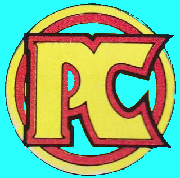 Just a few decades ago, astronauts, presidents and cowboys and were some of our cultural role models. But today’s cultural heroes are the brave souls who pitch their ideas on Shark Tank. So it’s not a surprise to find an entrepreneurial high school (or middle school) student who has created a cutting edge product, service or app. That’s why the subject of this week’s column is all the more impressive. In the early 80’s, two teenage brothers launched a their comic publishing business, showcasing talents like Jack Kirby, Steve Ditko, Neal Adams and Dave Stevens. At that time, they didn’t have any role models. They didn’t have weekly comic conventions in various cities. They were on the frontier with no maps or guidebooks.
Just a few decades ago, astronauts, presidents and cowboys and were some of our cultural role models. But today’s cultural heroes are the brave souls who pitch their ideas on Shark Tank. So it’s not a surprise to find an entrepreneurial high school (or middle school) student who has created a cutting edge product, service or app. That’s why the subject of this week’s column is all the more impressive. In the early 80’s, two teenage brothers launched a their comic publishing business, showcasing talents like Jack Kirby, Steve Ditko, Neal Adams and Dave Stevens. At that time, they didn’t have any role models. They didn’t have weekly comic conventions in various cities. They were on the frontier with no maps or guidebooks.
That’s why I’m so pleased to present my recent conversation with Bill Schanes. He’s a great guy who’s accomplished so very much in his career. Conversations with him could fill up several of these weekly columns. But for now, I will focus on the early days, and the origin of Pacific Comics.
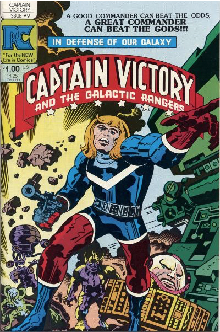 Ed Catto: Pacific Comics, as a publisher, was preceded by your mail order business, several comic shops and even a distribution business. How did you decide to start publishing Pacific Comics?
Ed Catto: Pacific Comics, as a publisher, was preceded by your mail order business, several comic shops and even a distribution business. How did you decide to start publishing Pacific Comics?
Bill Schanes: Since my brother Steve and I had several different but related businesses going at the same time, we noticed that there wasn’t very many “new” releases when it came to new comic books from the New York publishing houses. (It’s important to remember, the only mainstream publishers at that time were Archie, Harvey, DC and Marvel.) There were a number of “underground” publishers putting out books, like Print Mint, Rip-Off Press, Last Gasp, Kitchen Sink and others, but there just wasn’t enough new periodical releases to drive consumers into our stores on a weekly basis, so we decided to give it a try.
We first published a black and white comic book called ONE, which was part photo/illustration, and part traditional comic book style of artwork. We did this to make sure we fully understood how the whole editorial production cycle worked, plus we felt ONE had enough potential on its own to reach a wide range of consumers.
Most people don’t know this next tidbit, but we intended on our first major release to be a project Gil Kane was working on at the time – Blackmark.
Steve and I had also been involved with the San Diego Comic-Con since its second year (only missed the very first show), and during those early years, we got to know a number of the writers and artists who were the big names at the times, plus a wide range of new and upcoming talent as well.
EC: When you launched Pacific, the comics industry was very different than it is today. What are some of the major differences between the industry, then and now, specifically as it relates to publishing a new line of comics?
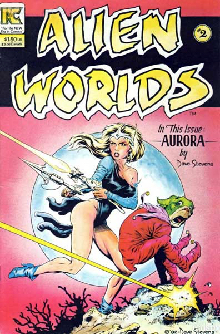 BS: As I mentioned previously, there were very few mainstream publishers releasing books at that time. The idea of a graphic novel or a trade paperback just wasn’t even being contemplated, except for a couple of exceptions.
BS: As I mentioned previously, there were very few mainstream publishers releasing books at that time. The idea of a graphic novel or a trade paperback just wasn’t even being contemplated, except for a couple of exceptions.
Those early days were very innocent, as there really weren’t any rules or boundaries at that time. Competition was limited in the “superhero’ genre to DC and Marvel only, so we felt there was a fairly large gap into what we thought the market would respond to, which was to break out of the mold, and introduce new concepts that featured the creative teams as much, if not more than the character name, as any characters that Pacific Comics would be introducing would be brand new to both retailers and consumers.
While we had a general idea as to what we wanted to publish, we didn’t have a formal business plan at that time (silly looking back on it now).
It’s also important to remember that in the late 70s and early 80s, there weren’t thousands upon thousands of comic book specialty retailers. Pacific Comics was also the largest wholesaler/distributor of comic books on the west coast at the time, so we had a very good relationship with the vast majority of the comic book specialty retailers out west. We felt that they would treat us as one of their own, as DC and Marvel were those New York guys, who really hadn’t established any type of retailer programs yet.
Pacific Comics was the first “mainstream” comic book publisher who exclusively sold into comic book specialty market retailers (no newsstand), so the retailers really responded positively to this via very large initial order commitments. We combined key creators (Kirby, Ditko, Adams, Wrightson, Jones…), with what at the time was cutting edge color separations (blue line/grey line), upscale paper stock, which allowed for higher quality reproduction, and heat set printing. This basically means that once the ink was applied to the paper, the ink “set” on top of the paper. This is opposed to the traditional cold press printing method of the previous 40+ years, which the ink absorbed into the paper, and also transferred to the readers’ hands fairly easily.
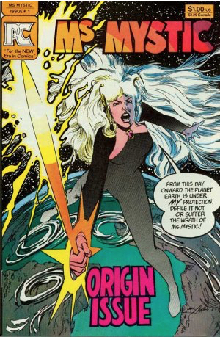 EC: The roster of Pacific creators reads like a who’s who of comics – Jack Kirby, Steve Ditko, Neal Adams, Dave Stevens, Sergio Aragones…the list goes on and on. Which creators are your favorites and why?
EC: The roster of Pacific creators reads like a who’s who of comics – Jack Kirby, Steve Ditko, Neal Adams, Dave Stevens, Sergio Aragones…the list goes on and on. Which creators are your favorites and why?
BS: We were very fortunate, as at the time Pacific Comics was going into the publishing of comic books, DC and Marvel had just come off one of their worst periods in regards to creator/talent relationships. We were also very lucky to have a number of very bright people working for us at the time, including David Scroggy (now at Dark Horse running their merchandise program), Jon Hartz (former original Valiant EVP), Bill Lund (one of the original founders and 1st chairman of the San Diego Comic-Con), and many others.
I had played with the idea of “ranking” the talent/creators based on sales of the books they had worked on over the recent past few years (somewhat similar to sports stats). At that time (before excel), I put together a grid of sales stats (on a large oversized graph paper), broken down by writer, penciller, inker, letterer, colorist, editor and any other individuals involved in the creative process. Each month, I’d update the data to include the most recent sales. I also put a “point value” on each sales level for each category of creator, so when we wanted to put together an editorial team, we wanted to make sure that each new book or story within a book would have a “point value” which we felt would represent the best opportunity to achieve sales of previous books they had worked on. While it wasn’t 100% scientific, it proved to be pretty helpful.
Now to get back to your question, after weren’t able to come to terms with Gil Kane on his Blackmark project, we said we might as well go with the biggest names in the business at the time. That meant that the #1 on our list, and one of all of our personal favorites was Jack Kirby. Jack had left the business for a while to work at Hanna-Barbera; mainly because he was dissatisfied with the work-for-hire concept that was the standard in the comic book business at the time, as he felt he should retain ownership and be entitled to royalties versus just a flat page rate with no back end compensation.
We also wanted to work with Neal Adams – who wouldn’t want to? – as well as some newcomers, like Dave Stevens. When we first saw the Rocketeer concept and early pages, we were left speechless, and knew immediately that Dave was heading to be one of the brightest and biggest names in the business (Dave was lost far too early, so sad).
We were aware that both Jack and Neal had long fought for creator rights, and we wanted to work with both, to show the creative community that Pacific Comics was a new type of comic book publisher, one who wanted creators to work with us versus having creators work for us.
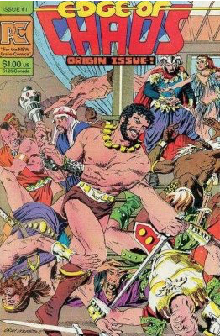 EC: Which projects or series were your favorites?
EC: Which projects or series were your favorites?
BS: Personally, I really enjoyed almost all of the books that April Campbell and Bruce Jones packaged for Pacific Comics. April and Bruce put together a series of fantastic titles, with all star talent involved. These included Twisted Tales, Alien Worlds, Pathways to Fantasy, Somerset Holmes to name a few. Jeffrey Catherine Jones, Berni Wrightson, Barry Winsor Smith, Tim Conrad, Art Adams, John Bolton, Joe Chiodo, Bo & Scott Hampton, Brent Anderson, and a host of others, plus April and Bruce wrote the majority of the stories, which lent to wonderful continuity along the whole line.
I also enjoyed the Elric series by P. Craig Russel (Mike Friedrich – from the then famous StarReach Productions) brokered this project with the creators.
Mike Grell was just in the middle of his fantastic run on Warlord, and we were really pleased to be able to publish his book Starslayer.
EC: And as a follow-up, which comics were you most proud of publishing?
BS: It’s hard to say anything other than KIRBY! The King had returned to comics and Pacific Comics engaged him on a creator ownership deal, whereby Pacific Comics licensed Jack’s titles from him, paid him a page rate, royalty from copy one, and at the end of the day, Jack owned 100% of his titles. (As it should be, as far as we were concerned).
Loved Dave Steven’s work on The Rocketeer.
April and Bruce were incredible to work with.
Steve Ditko did some back up features for us – I felt especially proud we were able to get Ditko back into the business (as we had done with Kirby).
SERGIO – need I say more! Sergio was, and is to this day, one of the nicest guys in the business. Sergio had done signings at our retail stores in the early 70’s, and was an absolute pleasure to work with (along with Mark Evanier).
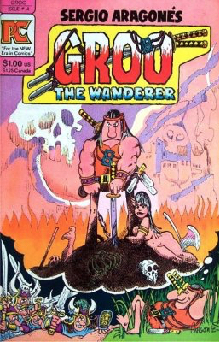 EC: I’m especially intrigued by the Somerset Holmes series by Bruce Jones and April Campbell, and their Hollywood struggle. What do you remember about that one?
EC: I’m especially intrigued by the Somerset Holmes series by Bruce Jones and April Campbell, and their Hollywood struggle. What do you remember about that one?
BS: Somerset Holmes was a series put together and packaged by April Campbell and Bruce Jones (a really terrific team). April was the main “model” for the lead character, and my wife at the time (Cynthia Lee Vice) was also involved in the photo shoots for reference materials used later on.
EC: After Pacific Comics, you started working at Diamond Comics. Can you tell us a little bit about how that came about, and what your responsibilities there were initially?
BS: After Pacific Comics wrapped up its various business entities in 1984, I took a few months off from returning to the workforce, just to recharge and see if I still had enough in me to give another run. I was 26 at the time, started Pacific Comics with my brother Steve when I was 13 and Steve was 17.
Sometime in the late summer of 1984, I had taken a few months off, and felt I could re-enter back into the industry that I loved so much. I reached out to Bud Plant (the largest wholesaler/distributor on the west coast), Russ Ernst (one of the largest mid-west distributors – Glenwood), Milton Griepp and John Davis (Capital City), and Steve Geppi (Diamond). These four interviews were all somewhat unique, as we both interviewed each other in regards to help to fully understand if we’d be a good fit together. They each had a long list of questions and talking points, and I also had put together a detailed list of questions and thoughts based on each of their individual strengths.
After these four interviews, I felt I could have the most impact by joining Diamond, which I did on November 11, 1985. I moved my family, dog and exotic African Macaw from San Diego to Baltimore via a semi-truck. I drove all 3,000 miles for the first time in that semi-truck.
When I got to Diamond, there were only a handful of employees at the “home office”. I originally handled customer service, sales, order forms (no Previews catalog yet) and “other duties as called upon.” Within my first week, I was attending a trade show in Chicago, with the instructions to meet with the largest accounts in the Chicagoland area (this included Moondog’s, Larry’s Comic Shop, Joe Sarno’s Comic Kingdom and Carl Bonasera’s Amazing Fantasy Comics.
EC: Looking back on your experiences with Pacific, is there any learning that you could offer to new publishers starting today?
BS: It seems to me in order to be a successful comic book publishers today, you need to do a number of things very well. These include (but aren’t limited to):
- Personal vision
- Business plan
- Dedication to honoring your word with both creators, comic book specialty retailers, media, and other 3rd party partners
- Relationship building
- Publishing on time, every time (leave no doubts that your serious about your publishing plans, and do what you say)
- Flexibility to change direction quickly
- Define what niche you are good at, and stick to what you know
- Financially ability to fund the start-up, building of, and continuing of your publishing business – over a 2-4 year time
- Treating creators (writers, artists, colorists, editors) and creator rights (outside of licensed books from major intellectually property owners like Warner Brothers, Disney, Fox…) with ultimate respect.
EC: Bill, great insights, stories and advice. What a treat! Thanks so much.











